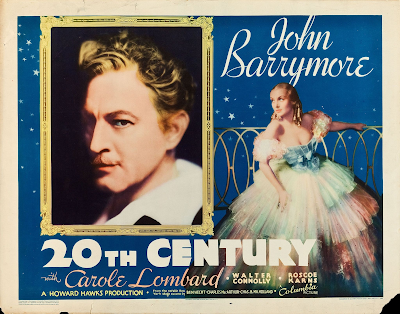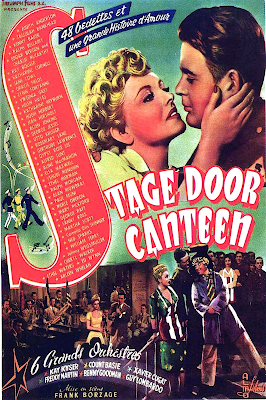Wonderland Burlesque's
Let's All Go To The Movies:
All The World Is A Stage
Part 4 of 12
This is the fourth of a twelve-part series of posts dealing with show business, be it the stage or soundstage.
Yes, show people, their tawdry little lives - in the theatre or movie studio - in all their glory, projected up there on the big screen, bigger than life; and they wouldn't have it any other way. For you see, they live for the stuff; the imitation glamor, the insufferable players, the exhausting rehearsals, and the oh-so important reviews - but above all else - they do it for the applause.
So hit the lights, for today, all the world is, indeed, a stage!
Stage Madness
(1927)
Madame Lamphier, a ballet dancer, tires of domestic life after the birth of her daughter, Dora, and returns to the stage. Her husband, Andrew, however, disappears with her daughter. Years later, Madame Lamphier is injured during a fall. When a younger girl threatens to take her place, Lamphier in a jealous rage shoots the manager, Pierre, and frames the girl for murder. When she discovers that the girl is her own long-lost daughter, she herself dies.
This drama was directed by Victor Schertzinger and stars Virginia Valli, Tullio Carminati, Virginia Bradford, Lou Tellegen, Richard Walling and Tyler Brooke.
The film was released on January 9, 1927, by Fox Film Corporation
Twentieth Century
(1934)
Broadway director Oscar Jaffe (John Barrymore) is a bigger ham than most actors, but through sheer drive and talent he is able to build a successful career. When one of his discoveries, Lily Garland (Carole Lombard), rises to stardom and heeds the call of Hollywood, Oscar's career begins to suffer. He hits the skids and seems on his way out, until he chances to meet Lily again, on a train ride aboard the Twentieth Century Limited. Oscar pulls out all the stops to re-sign his former star, but it's a battle - because Lily, who is as temperamental as Oscar, wants nothing to do with her former mentor.
Ben Hecht and Charles MacArthur adapted their 1932 Broadway play of the same name for this pre-Code screwball comedy which was directed by Howard Hawks and stars John Barrymore and Carole Lombard.
The play Twentieth Century was adapted from an unproduced play Napoleon of Broadway by Charles Bruce Millholland, based on Millholland's experiences working for legendary eccentric theater producer David Belasco.

Roy Del Ruth and Lewis Milestone had been set to direct before Howard Hawks got the job.
Before Carole Lombard was cast, Harry Cohn negotiated with Eugenie Leontovich, who had played the part on Broadway, and then considered Gloria Swanson and Miriam Hopkins. Other reports say that Cohn also approached Ina Claire, Tallulah Bankhead, Ruth Chatterton, Constance Bennett, Ann Harding, Kay Francis, and Joan Crawford. Miriam Hopkins turned down the role of Lily Garland.
When asked by John Barrymore why he should play the role of Oscar, Howard Hawks replied, "It's the story of the biggest ham on earth and you're the biggest ham I know." Barrymore accepted at once.
John Barrymore once said that the role of Oscar was "a role that comes once in a lifetime" and even deemed this his favorite of all the movies he appeared in.
Howard Hawks was concerned when Carole Lombard could not perform the kicking scene very well. Hawks took her out for a walk and recalls, "I asked her how much money she was getting for this picture. She told me ($2000) and I said, 'What would you say if I told you you'd earned your whole salary this morning and didn't have to act anymore?' And she was stunned. So I said, 'Now forget about the scene. What would you do if someone said such and such to you?' And she said, 'I'd kick him in the balls.' And I said, 'Well, he (John Barrymore) said something like that - why don't you kick him?' She said, 'Are you kidding?' And I said, 'No.'" Hawks ended the conversation with, "Now we're going back in and make this scene and you kick, and you do any damn thing that comes into your mind that's natural, and quit acting. If you don't quit, I'm going to fire you this afternoon." Hawks' white lies did the trick, and the scene was filmed. In addition, Hawks claimed that after that, Lombard never began another movie without sending him a telegram that read, "I'm gonna start kicking him."
Howard Hawks allowed John Barrymore and Carole Lombard to improvise freely during filming. "When people are as good as those two, the idea of just sticking to lines is rather ridiculous," he told Peter Bogdanovich in an interview. "Because if Barrymore gets going, and he had the ability to do it, I'd just say, 'Go do it.' And Lombard would answer him; she was such a character, just marvelous." Hawks then told a story about Lombard coming to him one day to complain about studio head Harry Cohn making passes at her. Between them, the director and star worked out a plan to embarrass their boss. Hawks was in Cohn's office, having a serious discussion with him, when Lombard burst in to exclaim, "I've decided to say yes!" As Cohn watched in shock, she made as if to begin removing her clothes. Hawks said self-righteously, "I'd better get out of here if this is the kind of studio you run." A shaken Cohn asked Lombard to leave, and she never had any further problems with him.
After filming had ended, John Barrymore gave Carole Lombard an autographed photo inscribed, "To the finest actress I have worked with, bar none." Carole Lombard and John Barrymore became friends during filming. When Barrymore's career was declining, Lombard raised hell to get him to work on her film True Confession (1937).
Along with Frank Capra's It Happened One Night, also released in 1934 (which coincidentally has the same music over the opening titles), Twentieth Century is considered to be a prototype for the screwball comedy. "Howard Hawks' rapid-fire romantic comedy established the essential ingredients of the screwball – a dizzy dame, a charming, but befuddled, hero, dazzling dialogue, and a dash of slapstick." Its success propelled Lombard into the front ranks of film comediennes.
Howard Hawks had signed a three-picture deal with MGM in 1933 and claimed that he made this film at Columbia while on a "paid vacation" from the other studio. "I got Barrymore and Lombard and made the picture in three weeks' time," Hawks boasted to an interviewer. In truth, however, shooting continued through another week due to the director's habit of drilling his cast in their lines and demanding retakes to get the rapid-fire delivery he wanted. This movie was the first film in which Hawks pushed this technique to its limit - and a prime example of its effect, though it certainly can be seen in his later comedies.
Much of the film is set on the 20th Century Limited train as it travels from Chicago to New York City. Ben Hecht and Charles MacArthur adapted their 1932 Broadway play with uncredited contributions from Gene Fowler and Preston Sturges.
John Barrymore and Carole Lombard
--- ---
Stage Door
(1943)
This World War II film with musical numbers and other entertainment interspersed with dramatic scenes by a largely unknown cast was produced by Sol Lesser's Principal Artists Productions and directed by Frank Borzage. The film features many celebrity cameo appearances but primarily relates a simple drama set in the famed New York City restaurant and nightclub for American and Allied servicemen. Six bands are featured. The score and the original song, We Mustn't Say Goodbye, were nominated for Academy Awards.
The real Stage Door Canteen at 216 W. 44th St., in Times Square, was unavailable for filming, as it was still an operating as a nightclub during World War II. So, it was recreated at R.K.O. Radio Pictures studios in Culver City, California - although all of Benny Goodman's scenes were filmed in New York City, at the actual Stage Door Canteen.
Producer Sol Lesser paid the Stage Door Canteen fifty thousand dollars for the use of its name. They and Allied Charities received the profits from this movie.
Features Peggy Lee's film debut, singing Why Don't You Do Right? with Benny Goodman and his orchestra.
The Girl I Love to Leave Behind, by Richard Rodgers and Lorenz Hart, was presumably written for (and discarded from) their stage musical By Jupiter (1942), which was then running on Broadway starring Ray Bolger, who performs the song in this film.
This movie's storyline of a GI's romance with a canteen girl named Irene was inspired by the song, I Left My Heart at the Stage Door Canteen, written by Irving Berlin, and recorded in 1942 by Kenny Baker (who appears in this movie). The opening lyrics of the song are, "I left my heart at the Stage Door Canteen / I left it there with a girl named Irene."
Stage Door Canteen is in the public domain in North America. There are two versions of this film - one that runs two hours and twelve minutes, and a shorter television version, which runs one hour and thirty-three minutes, which is the most common one available.

Bühne frei für Marika
(1958)
AKA: Clear The Stage for Marika
Marika Rökk
--- ---
Stage Fright
(1987)
AKA: Deliria, Bloody Bird, Aquarius
This marked Michael Soavi's directorial debut. He has said of Stage Fright that he "didn't feel ready to direct, but of course I said 'yes' when I was offered a chance."
--- ---
And that's all for now.
Tune in next time...
Same place, same channel.
Why Don't You Do Right? - Peggy Lee w/
Benny Goodman and His Orchestra
from the 1943 motion picture Stage Door Canteen










.jpg)















































































4 comments:
Carole Lombard was stunning!
And is that Drew Barrymore's grandpa??
XOXO
I remember seeing Stage Door Canteen a few dozen times on late night TV in So Cal in the 70s. It was always entertaining.
What an amazing post! I've always loved the name of that line, so grand - and all those Barrymore and Lomabard anecdotes! I'm dying, wonderful!! And to cap it off with Lee - "get outta here and get me some money too .."
I had to post again because I just saw Roscoe Karns in the cast of 20th Century! On the old Dumont Network he was "Rocky King, Detective". And he also had a small role with Ramon Novarro in The Flying Fleet. Wow!
Post a Comment